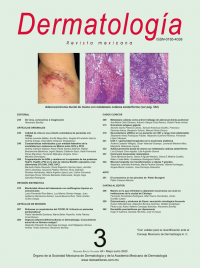Quality of life in Colombian patients with vitiligo.
Dermatol Rev Mex. 2020 mayo-junio;64(3):239-247.
Andrea Laverde-Walter,1 Ana M Maya-Rico,1 Ángela M Londoño-García,2 Andrea Arango,2 Elsa María Vásquez-Trespalacios3
1 Residente de Dermatología.
2 Dermatóloga docente.
3 Epidemióloga docente.
Universidad CES, Medellín, Antioquia, Colombia.
Resumen
ANTECEDENTES: El vitíligo es el principal trastorno adquirido de despigmentación en todo el mundo y, aunque no causa molestias físicas directas, puede ser psicológicamente angustiante en los pacientes que lo padecen con afectación de su calidad de vida.
OBJETIVO: Evaluar la calidad de vida de los pacientes adultos con vitíligo de un centro dermatológico colombiano de referencia.
MATERIAL Y MÉTODO: Estudio transversal, con intención analítica efectuado de junio a diciembre de 2018 en el Centro de Dermatología IPS CES Sabaneta, Colombia, donde se incluyeron pacientes adultos con vitíligo. Todos los pacientes contestaron los cuestionarios DLQI y VitiQoL para evaluar la calidad de vida.
RESULTADOS: Se evaluaron 110 pacientes mayores de 18 años con vitíligo, 56.4% (62) mujeres y 43.6% (48) hombres, con edad media de 46 ± 12.8 años. El 71% (79%) de los pacientes obtuvo puntajes leves en el DLQI y el promedio de VitiQoL fue de 31.29 ± 23, con mayor puntaje en las preguntas respecto a la esfera del comportamiento (media 3.96). Según el VitiQoL, los pacientes con educación básica secundaria y universitaria tuvieron menor alteración de la calidad de vida con coeficiente de –14.88 y –16.17, respectivamente (p < 0.018 y 0.031, respectivamente).
CONCLUSIÓN: La afectación de la calidad de vida en nuestros pacientes con vitíligo fue leve, con mayor alteración en la esfera del comportamiento y con menos efectos en quienes tienen niveles de escolaridad secundaria y superior.
PALABRAS CLAVE: Vitíligo; calidad de vida; cuestionarios.
Abstract
BACKGROUND: Vitiligo is the main worldwide acquired skin depigmentation disorder and although it does not cause direct physical discomfort, its presence can be psychologically distressing in patients who suffer from it, affecting their quality of life.
OBJECTIVE: To evaluate the quality of life of adult patients with vitiligo from a dermatological Colombian center of reference.
MATERIAL AND METHOD: A cross-sectional study with analytical intent was carried out from June to December 2018 at the IPS CES Sabaneta dermatology center, Colombia, where adult patients with vitiligo were included. All patients answered the DLQI and VitiQoL questionnaires to assess quality of life.
RESULTS: One hundred and ten patients older than 18 years with vitiligo were evaluated, 56.4% (62) women and 43.6% (48) men, with an average age of 46 ± 12.8 years. 71% (79%) of the patients obtained slight scores in the DLQI and the average of VitiQoL was 31.29 ± 23, with a higher score in the questions of behavior sphere (mean 3.96). According to the VitiQoL, the patients with high school and university education showed a minor alteration of the quality of life with a coefficient of –14.88 and –16.17, respectively (p < 0.018 and 0.031, respectively).
CONCLUSION: The affectation of the quality of life in our patients with vitiligo was slight with greater alteration in the sphere of behavior and with less impact in those who have secondary and higher levels of schooling.
KEYWORDS: Vitiligo; Quality of life; DLQI; Questionnaires.

